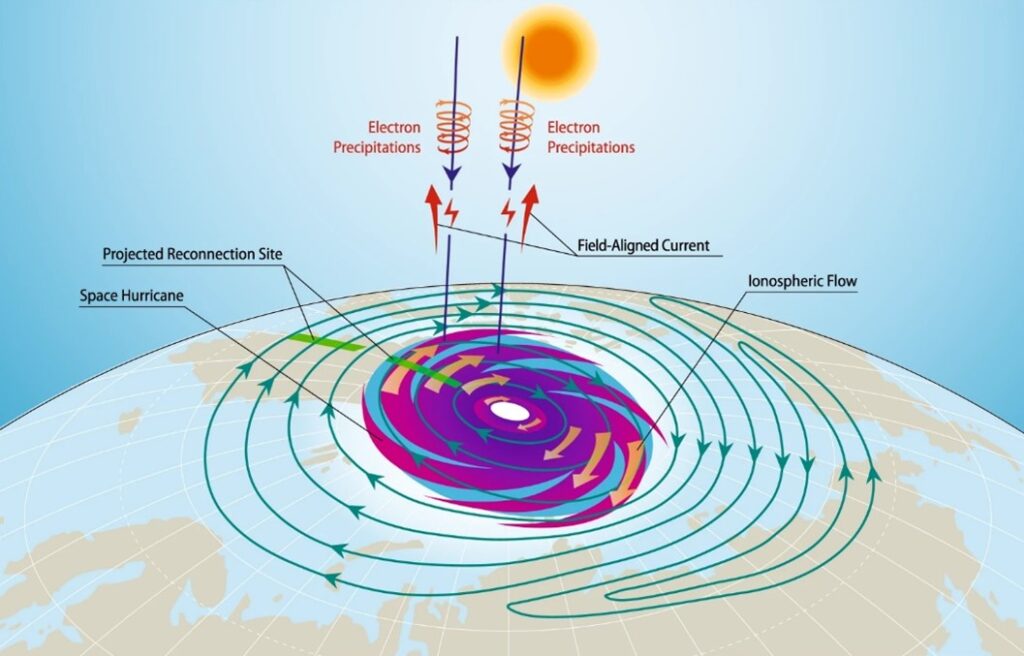
Diagram of a space hurricane over the Earth’s Arctic region. Zhang, Q., et al. (2021).
Earth’s atmosphere is studied in layers that begin closest to the ground with the troposphere and proceed to the stratosphere, mesosphere, thermosphere, and, finally, the exosphere.
The ionosphere is in the thermosphere, part of the upper atmosphere. Scientists did not expect to find storms of electrons, dubbed “hurricanes”, that close to outer space, but nature never fails to surprise.
“The ionosphere is the ionized part of the upper atmosphere of Earth, from about 48 km to 965 km above sea. The ionosphere is ionized by solar radiation. It plays an important role in atmospheric electricity and forms the inner edge of the magnetosphere. It (…) influences radio propagation to distant places on Earth” (Wikipedia).
In a 2021 paper in the journal Nature, Professor Qing-He Zhang, from the Institute of Space Sciences, Shandong University, China, and co-authors reported the discovery of a long-lasting space hurricane in the ionosphere and magnetosphere near the North Pole. A year later, researchers from the same group, now led by Sheng Lu, have probed more deeply into this unexpected phenomenon. After a long-term optical observation, they found the conditions that make these so-called “space hurricanes” most likely to occur in the Northern Hemisphere. Their results were published in the journal Frontiers in Astronomy and Space Sciences.

“Auroras are caused by the interaction of energetic particles (electrons and protons) of the solar wind with atoms of the upper atmosphere.” (Britannica). Photo: Svein-Magne Tunli.
The new study found that these funnel-shaped electrical formations near the North Pole are massive, with over 600 miles (around 1,000 km) in diameter.
The observations were made about 860km above the surface. To Larry Lyons, a space physicist at UCLA who co-authored both studies, these findings were shocking, as these hurricanes were “occurring where nobody looked and occurring under conditions where nobody thought anything was happening.”
Traditional auroras and these space hurricanes have similar characteristics in color, speed, and altitude. However, the recently discovered phenomenon occurs in considerably higher latitudes than typical auroras, near the North Pole where researchers previously believed the auroras to be much weaker.
Plus, space hurricanes can spin for eight hours, which is a lot of time considering traditional auroras only last minutes. As well, they occur during periods of low disturbances in the Earth’s magnetic field, while traditional auroras are triggered by magnetic disruption of electrically charged particles in the solar wind.
“An aurora, also commonly known as the polar lights, is a natural light display in Earth’s sky, predominantly seen in high-latitude regions (around the Arctic and Antarctic). Auroras display dynamic patterns of brilliant lights that appear as curtains, rays, spirals, or dynamic flickers covering the entire sky” (Wikipedia).
The Sun’s surface frequently explodes in flares of energy that fuel the solar wind, a stream of charged particles released from the outer layers of the Sun.
When the solar wind increases in intensity, it can disturb the Earth’s magnetosphere, the magnetic shield that protects the Earth from radiation and damaging solar particles. The beautiful and colorful lights we know as aurora borealis result from changes in the configuration of the magnetosphere’s magnetic lines, which excite molecules in the atmosphere and emit photons of light.
“In astronomy and planetary science, a magnetosphere is a region of space surrounding an astronomical object in which charged particles are affected by that object’s magnetic field” (Wikipedia).

Artist’s rendition of Earth’s magnetosphere. Image: NASA.
The researchers analyzed more than 300 space hurricanes over 11 years and created a 3D model of the storms in the ionosphere. Given the characteristics of this part of Earth’s atmosphere, filled with electrically charged atoms known as ions, space hurricanes do not rain water, but electrons.
These recent observations were the first proof that space hurricanes exist. “To prove this with such a striking observation is incredible”, said Dr. Mike Lockwood, from the University of Reading, in the UK, who co-authored the 2021 study.
However, others like Dr. Maria Walach from Lancaster University argue that it’s possible this is not a new discovery, but instead a higher-resolution rendering of a previously observed phenomenon called a high-latitude dayside aurora.
Further investigations will reveal if we are dealing with the same phenomenon or not.
Scientists believe that these space hurricanes might be somewhat frequent among the many planets, natural satellites, brown dwarfs, and even comets that also host the traditional version of auroras. It could be that the presence of magnetic fields and plasma is enough for other planets and moons out in the cosmos to experience these dancing colorful lights in the sky (although an observer may also be required).
“Plasma is superheated matter – so hot that the electrons are ripped away from the atoms forming an ionized gas. It comprises over 99% of the visible universe. In the night sky, plasma glows in the form of stars, nebulas, and even the auroras that sometimes ripple above the north and south poles. (…) Plasma is often called “the fourth state of matter,” along with solid, liquid and gas.” (Plasma Science and Fusion Center, MIT).
These findings shed more light on how space weather affects radio communication and navigation systems, for instance, by interrupting radio waves passing through the upper atmosphere. Space weather can also increase the temperature in the upper atmosphere, which has consequences for satellites in orbit. Although scientists believe space hurricanes pose no serious risks to human life on land or in space, it’s important to learn more about the effects of the electrons they shower down onto us.
“From both the communications and the navigation points of view, this looks like it will be something we want to add to our predictions for aircraft flying polar routes”, said Professor Zhang.



